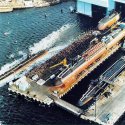‘We’re sending an armada’
On April 10, President Trump threw gasoline on a growing fire by implying in an interview with Fox Business News that the administration had directed the carrier to proceed to Korea.
"We are sending an armada, very powerful," he said. "We have submarines, very powerful, far more powerful than an aircraft carrier, that I can tell you."
The confirmation of the misleading narrative from the commander in chief — as well as the allusion to nuclear-armed ballistic missile submarines — sent the crisis into overdrive.
Governments in Seoul, Pyongyang, Tokyo and Beijing began reacting to what looked like an emergency with the speedy U.S. carrier beelining to the Sea of Japan. The situation became even more muddied when Mattis tried to tamp down the frenzy during a press conference, telling the reporters — inaccurately — that the announcement of the carrier move was not from a specific demand signal but was instead announcing the canceling of the exercise with the Australians, which the Vinson was at that moment participating in.
Some reporters were getting it right. After the confusing press conference, USNI News’s Sam LaGrone
and reported that Vinson was participating in the exercises before heading to North Korea. But in the larger media, major outlets were reporting what by now was accepted (but completely wrong) wisdom: that Vinson and her escorts were headed for a confrontation with Kim Jong Un.
On April 12, the media frenzy prompted a call from Chinese President Xi Jinping to Trump, with Xi urging all sides
. At the same time, North Korean officials were taking to the airwaves to warn that “thermonuclear war" was imminent.
Behind the scenes at the Pentagon and out in the Pacific, officials were trying to put the brakes on what was by now a runaway train.
“Everyone who asked was told the same thing -- that the carrier was doing exercises with the Australians and then was proceeding north after that,” an official said, a statement that echoed what several other sources told Navy Times.
Many reporters, however, weren't bothering to check on the status of the carrier, multiple officials said. Across the world, U.S. military officials were watching the story spin out of control but didn’t know quite what to do about it. The carrier was, after all, getting to North Korea eventually.
“You know things have gotten out of control when CNN is playing the story on loop every 90 minutes,” a defense official said.
The story was everywhere, noted another official.
“You couldn’t walk by a TV screen without that story smacking you in the face.”
‘Preemptive strikes’: a crisis fizzles out
The come-to-Jesus moment for officials
when NBC News filed an April 13 story cited to “intelligence officials” that said if Pyongyang moved to light off a nuclear test, the military was preparing a massive preemptive strike.
And while PACOM was forming options to present the President, the report described the situation as considerably more dire than it was, officials said.
“It was fake news,” one official said.
After the alarming report from NBC, more reporters began checking with media offices in the Pentagon and in the Pacific and it became clear that everything was not as it seemed. The story line, however, continued through the weekend news cycle despite the fact that many Pentagon reporters were telling their bureaus that the notion that Vinson was steaming towards Korea was wrong, multiple officials said.
The crisis came to a screeching halt on April 17, when Navy Times' sister publication Defense News published a story with a revelation that stunned governments and media worldwide: Vinson hadn’t gone north at all, but had headed the exact opposite direction to participate in exercises. The story was based on pictures posted on official Navy websites showing the carrier transiting the Sunda Strait, between the Indonesian islands of Sumatra and Java: 3,500 miles from Korea.
In South Korea, the media pounced, calling the Trump administration liars on par with North Korea, which often exaggerates and bluffs to intimidate perceived adversaries.
“The 50 million South Koreans, as well as many common-sensical people around the world, cannot help but feel embarrassed and shocked,” said the spokesman of Korea’s main opposition party,
.
Growing pains
With the benefit of hindsight, officials in the Pentagon and in the Pacific said they should have done more to nip the story in the bud before it got out of control.
“In my view, we shouldn’t have announced the port cancellation so early,” one official mused.
But many defended the decision to make the announcement, saying there was no way that they could tell 5,000 families on the Vinson that their port visit to Australia was canceled and it not get out.
“It would have lit up social media immediately and then we would have had to make the announcement anyway,” another official said.
Jerry Hendrix, a retired Naval Flight Officer and now analyst with the Center for a New American Security, said the fact that the announcement came on the heels of the Syria strike, and that subsequent use of the “mother of all bombs” in Afghanistan, framed what was a reasonable and routine Navy move of sending the carrier where the crisis is seem like a bigger deal than it was.
“What you are seeing here is a reaction to a more activist foreign policy with the Trump administration,” he said.
Obama’s more cautious approach to foreign policy made moving a carrier into a contentious region seem less threatening than it does under Trump, especially since Trump has made seapower and growing the Navy a key part of his defense strategy, Hendrix argues.
“Moving a carrier means something very different today than it did under a more cautious, lead-from-behind Obama administration.”




